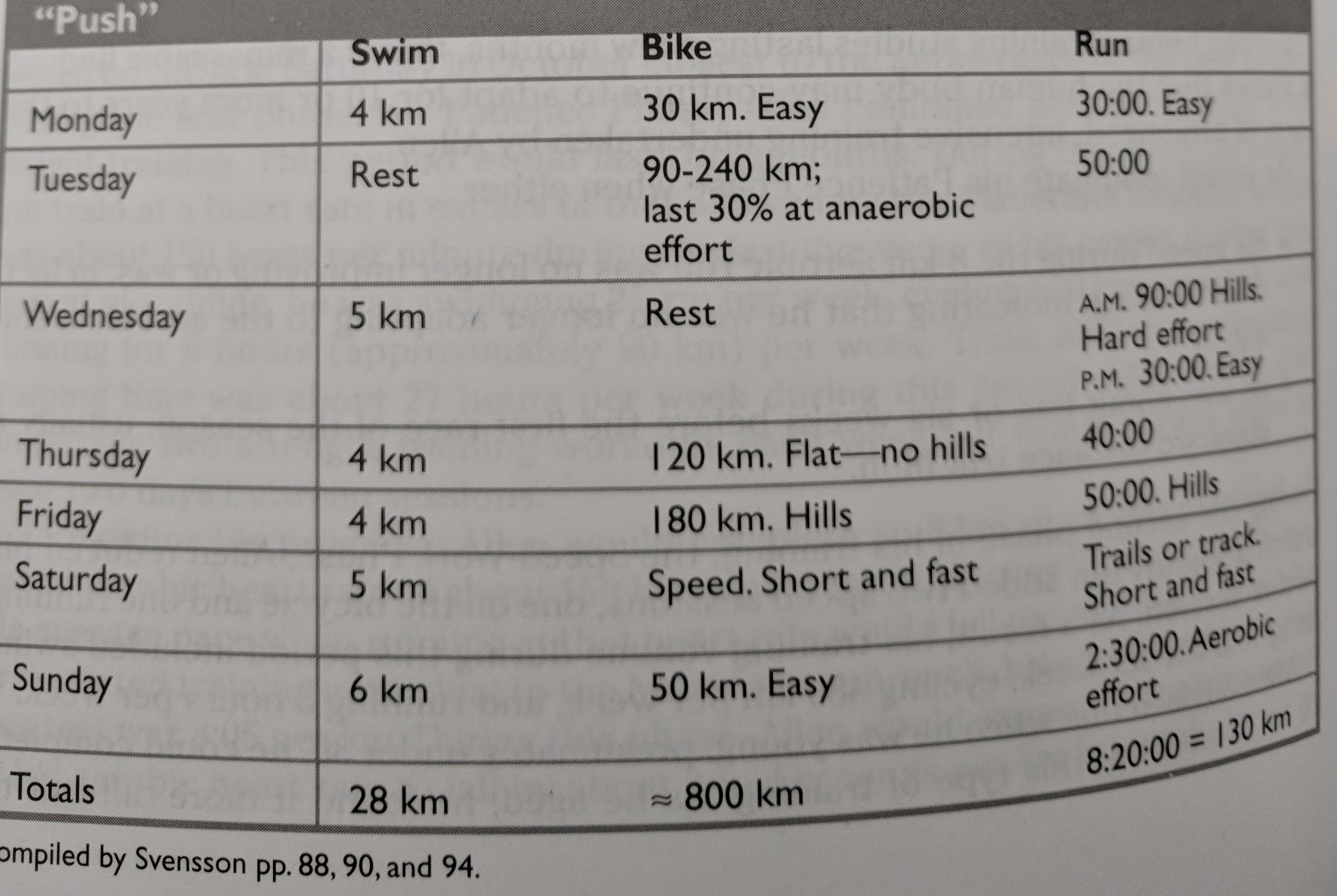The most important Ironman training block: 'The Big Push'.
Alan Couzens, M.Sc.(Sports Science)
Sep 19, 2018

“8 weeks before the Hawaii Ironman, Mark Allen begins the ‘push’ phase of his training. This consists of four hard weeks of training followed by a 4 week taper. During this time, Allen doesn’t race at all. This period of training is, in my view, the most taxing training ever performed by a human, exceeding even that of the Kenyans” – Tim Noakes (Lore of Running)
It has been an interesting year for me, thus far. Perhaps, more than any year to date, I have been interrogating athlete data with a little extra vigor and vigilance :-) Largely, due to my new found obsession with Machine Learning and, more specifically, the application of ML to optimizing endurance training.
One of the key questions that I have been asking the data is "what is the optimal distribution of training volume and intensity over the year?" This is a persistent question in performance modeling going all the way back to Banister. One of the key charts that Banister created was the ‘influence curve’ – a visual representation of the impact that a given load will have on performance, depending on when it is completed with respect to the event. I wrote a little more about that here. If you look at the chart on that post, you'll see that for the bulk of athletes, what happens in that ~30 to 60 day window before the event has, by far, the largest impact on performance.
Interestingly, this observation of the huge importance of the timing of the load has been showing up irrespective of which model I apply. For example, when I applied a (superior) Neural Network model to my athlete data, a little surprisingly, the accuracy of the model really doesn’t improve very much with the addition of data beyond 8 weeks from the event. The error (RMSE) for a single month NN dose-response model across the group is +/- 8.0%. It improves by ~an additional percentage point (7.1%) when an additional 4 weeks of volume/intensity training data is added. However, it doesn’t budge much more than that even if I include a further 6 months of athlete training data! That is to say that almost all of the information that the model needs to predict the athlete's performance can be found in the last 8 weeks of training data leading up to the event! The long and short of that is that what happens within that critical 8 week period before a big race has a huge bearing on the end result!
And, of course, the way that we structure what happens within that 8 weeks is equally important. If I model out the difference between an 8 week block of training in 2 different ways
- – 4 weeks at 50% less than normal load + 4 weeks at 50% higher than normal load
- – 4 weeks at 50% MORE than normal load + 4 weeks at 50% less than normal load
The difference in predicted performance between the 2 strategies is in the range of 6%, i.e. a performance difference of 30 minutes or more in Ironman time over the day! No difference in the total load, only difference is the timing of the load.
Bottom lining it, in addition to a taper being obviously important to performance, what happens in that 4-8 week overload period before a key event is equally important. We call this critical time period “The BIG push”
For Mark Allen, that 4 week “Big Push” period looked like this (Noakes, 2003)….

You can see why Noakes suggested that it may be the most taxing training performed by any human – in this case, a human that also happened to win the most coveted title in Triathlon a total of 6 times!
The other guy in the pic above who has an equally impressive resume employed a similar strategy. From Triathlete magazine's article on Dave's comeback at age 40...
"...so, for the final prep, I went to Steamboat Springs (high altitude) for 3 weeks. I was training alone. It was a test to see if I could do it myself, of how self-motivated I was. Nobody was pushing me. I developed my own mental tenacity...The last 6 weeks of training, not including my taper, my weekly mileage was 320 (mountainous miles) on the bike, 60 on the run plus 20,000 yards of swimming. Plus, I lifted weights 3 times a week."
Of course, your own version of “The Big Push” may be a little more tame. Allen’s average week during the base period was in the range of 25-26hrs Therefore, the 38hrs, while extreme by most standards, fell in nicely with that +50% increase that I modeled above. For a competitive age-grouper with an average week of ~18hrs, this key 4 week block may average closer to 27hrs/wk. For the athletes that I work with, especially working age-groupers, the big volume increase in this time is usually facilitated by 3 solid weeks (~25hrs) with a good dose of race pace work coupled with a Big Week Training camp of ~30hrs within that period.
Whichever way you accomplish it, the importance of this key 4-8 week out period can’t be overstated. I'm sure that the importance that I place on this block is currently all too evident in the legs of the athletes that I’m working with as we head into a very well earned taper period! :-) Frankly, it's been quite a month for the team with athletes putting in some of the most impressive training weeks that I've seen to date! It may or may not be coincidental that I’m choosing to post this as our designated ‘Big Push’ period comes to a close. See you in Kona ;-)
Train smart,
AC
TweetDon't miss a post! Sign up for my mailing list to get notified of all new content....
